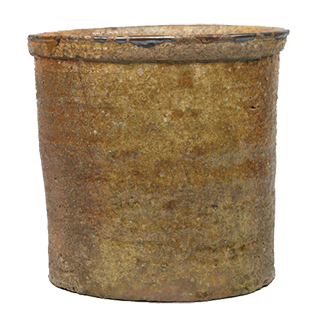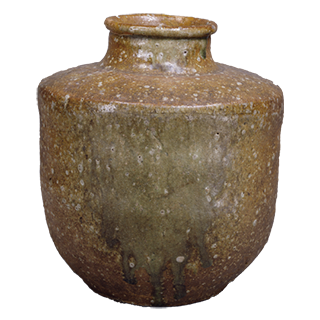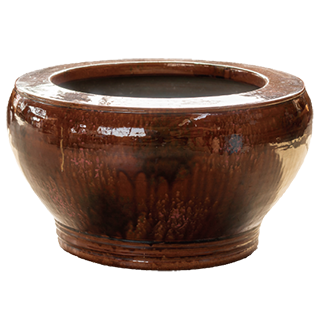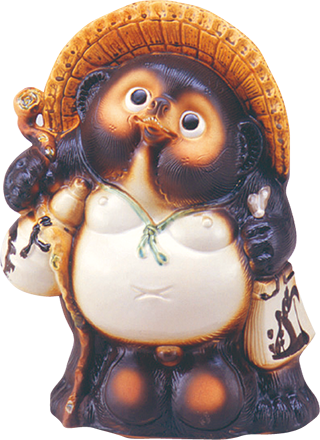
The History of
Shigaraki Ware


Koka City, where Shigaraki ware is made, is located in the southeastern part of Shiga Prefecture and is situated in a wide-area transportation hub within 100 kilometers of both Osaka and Nagoya. Minakuchi and Tsuchiyama have long prospered as post towns on the 53 stations of the Tokaido Highway, and tea production has served as a local industry to support the economy there. Shigaraki is located in Koka City, in a mountainous area on the border of Kyoto and Shiga prefectures, and despite being a remote area with a harsh natural environment, pottery production has become the distinctive industry of the area. The Shigaraki area is blessed with clay soil of good quality, and due to its ability to withstand heat and its coarseness, it is well suited for large and thick works such as jars for water, seed, and tea, as well as tea utensils, sake bottles, braziers, and flowerpots.
Distinctive Works
Through the Ages
Shigaraki, along with Seto, Echizen, Tokoname, Tamba, and Bizen, is one of the “Six Ancient Kilns of Japan”, all of which have histories that range from several hundred years to more than a thousand.
Muromachi
& Azuchi-Momoyama Periods
From the Muromachi Period (1333-1573) onward, the production of tea ceramics flourished thanks to the help of the tea ceremony, which is said to have been greatly developed by Sen no Rikyu.

*1: Onioke water jar
Edo Period
During the Edo Period (1603-1867), tea jars given as gifts to the Shogun, as well as tableware for everyday use such as teapots and sake bottles began to be produced to meet the changing lifestyles of the people.

*2: Tea jar
Meiji Era to Early Showa Era
Production of braziers and flowerpots began in the Meiji Era (1868-1912), and from the Taisho Era (1912-1926) to the prewar period of the Showa Era (1926-1989), the Shigaraki area established itself as a major producer of braziers.

Tanuki Figures
When Emperor Showa visited Shigaraki, he was welcomed with a row of Shigaraki tanuki (Japanese raccoon dog) figures all bearing Japanese flags. This sight greatly pleased Emperor Showa, and press reports stated that he wrote the following poem, which succeeded in drawing the entire country’s attention to Shigaraki tanuki: “Seeing the Shigaraki ware tanuki gives me feelings of nostalgia for the days I collected them in my youth.”

What is Chanoyu?

Chanoyu refers to a form of tea ceremony in which the host prepares and serves tea to their guests, who then enjoy it together.
Murata Juko, a Buddhist monk and tea ceremony master from the Muromachi Period (1333-1573), established the Wabicha style of tea ceremony, which placed importance on the spiritual exchange between the master and his guests, by introducing simple tea ceramics called Wamono, that made use of the earthiness of Shigaraki and Iga in Japan, in contrast to the flashy, ornate Chinese tea ceramics called Karamono that were typically used in the tea ceremonies until then. The spirit of Wabicha was later passed down to Takeno Jo-o, and his disciple Sen no Rikyu developed it to its fullest extent during the Momoyama Period (1573-1600).
Shigaraki Ware
as Tea Utensils
The rustic simplicity and Japanese sensibility of Shigaraki made it popular among tea masters in Nara, Sakai, and Kyoto, and it came to be recognized as a kiln for ceramics used in tea ceremony. Particularly, in the late Muromachi Period (1336-1573), tea master Takeno Jo-o was enamored with the elegance of old Shigaraki ware, and the Shigaraki ware tea ceramics he had made was known as “Jo-o Shigaraki”. This is said to have been the catalyst for the creation of pottery named after great tea masters in later generations. Sen no Rikyu, whose style of tea ceremony was strongly influenced by Jo-o, also created “Rikyu Shigaraki” of his own design. Thus, in the Momoyama Period (1573-1600), high-quality Shigaraki ware tea utensils became an indispensable part of tea ceremonies.
“Jo-o Shigaraki”
Uzukumaru flower vase *3
Muromachi Period, 15th century; Tokyo National Museum
This small, medieval-era Shigaraki vase was used as a flower vase in the world of the tea ceremony. This piece was a favorite of tea masters, and was called “Uzukumaru” (crouching) because of its resemblance to a person crouching with their back bent.

※3
“Rikyu Shigaraki”
Straight-lipped water jar, signed “Shiba no Iori” *4
Azuchi-Momoyama Period, 16th century;
Tokyo National Museum"
The front, covered with a pale yellow-green natural glaze, has some cracks in it, while the sides are blackened and charred to create a different kind of appearance. This piece is representative of Shigaraki water jars.

※4
source
- *1: Created using ColBase (Integrated Collections Database of the National Institutes for Cultural Heritage, Japan)
(https://colbase.nich.go.jp/collection_items/tnm/G-5105?locale=ja) - *2: Created using ColBase (Integrated Collections Database of the National Institutes for Cultural Heritage, Japan)
(https://colbase.nich.go.jp/collection_items/tnm/G-3661?locale=ja) - *3: Created using ColBase (Integrated Collections Database of the National Institutes for Cultural Heritage, Japan)
(https://colbase.nich.go.jp/collection_items/tnm/G-5025?locale=ja) - *4: Created using ColBase (Integrated Collections Database of the National Institutes for Cultural Heritage, Japan)
(https://colbase.nich.go.jp/collection_items/tnm/G-5307?locale=ja)
Characteristics of
Shigaraki Ware
Clay
The clay used for Shigaraki ware has high heat resistance and a coarse texture.
About 4 million years ago, there was an ancient lake near Shigaraki which would eventually become Lake Biwa, that produced a clay-rich soil from a stratum known as the Old Biwako Layer that is ideal for use in pottery. The potter’s clay is kneaded with various types of clay such as Kibushi and Mizuchi, as well as other materials, which results in a clay with a strong, sticky consistency that is well suited for large works with thick walls.
Firing
“Scarlet”
The firing process produces a warm, beautiful fire color (scarlet) unique to Shigaraki that resembles skin tones such as pale orange, pink, and reddish brown.
“Haikaburi”
When ash accumulated inside the kiln covers a piece of pottery that is being fired, those areas develop a blackish-brown color. The rusty appearance of this coloring, known as Haikaburi, is highly valued in ceramics used for tea ceremonies.

Glaze
Until the Edo Period (1603-1867), Shigaraki ware was made without glaze and fired at high temperatures. During the firing process, ash from the burning firewood accumulates on the surface of the pottery, and this ash fuses with the feldspar contained in the clay to form a glassy blue-green or yellowish-green sediment known as called “natural glaze (vidro glaze)”, and the way it is created through the weaving together of clay and fire embodies the Japanese “Wabi-Sabi” spirit.

Kiln
“Climbing Kiln”
This is a long, continuous kiln built on the ascending slope of a mountain. As it is designed to heat the rear chamber while utilizing the residual heat from the front chamber, this type of kiln is said to be very efficient in that large amounts of pottery can be fired in a short amount of time using a small amount of fuel. Additionally, because firewood is used to fire the pottery, it is possible to achieve the scarlet color and Haikaburi that are the distinctive features of Shigaraki ware.

